#grumman northrop aerospace
Explore tagged Tumblr posts
Text

EA-6B Prowler’s taxi in the rain at Misawa AB japan🇯🇵
@headdancer7 via X
16 notes
·
View notes
Text

Proteus high altitude aircraft over Las Cruces New Mexico - March 15 2002
#Proteus#Model 281#high altitude aircraft#experimental aircraft#Northrop#Grumman#aircraft#aerospace#aviation
24 notes
·
View notes
Text
Top CIA Scientist Secretly Cracked Gravity
youtube
#science#physics#ufos#cia#history#albert einstein#bob lazar#cover up#technology#aerospace#antigravity#government#deep state#northrop grumman#lockheed martin#robert oppenheimer#david grusch#skunk works#astronomy#time travel#quantum physics#national security#secret space program#propaganda#space travel
8 notes
·
View notes
Text
This me in a couple of months now:

#stemblr#i guess#add Northrop Grumman there too for extra spice#or any other defense company really#aerospace engineering#couldn't get into SpaceX#so this will be it I guess#memes image#defense industry#arktos.png#/hj#there migh be no morality but at ñeast there's big bucks#*least
6 notes
·
View notes
Text
How Is Orbital Sciences Corporation Shaping the Space Launch Services Market? Innovations and Strategies

Introduction:
Orbital Sciences Corporation, now part of Northrop Grumman Innovation Systems, has been a significant player in the Space Launch Services Market. Renowned for its pioneering role in developing and launching space technologies, the company has consistently adapted its strategies and innovations to meet the evolving demands of space exploration and commercialization.
This article explores how Orbital Sciences Corporation, through its recent strategies and developments, has impacted the space launch services market.
Download FREE Sample: https://www.nextmsc.com/space-launch-services-market/request-sample
1. Strategic Focus on Reusable Launch Systems
Orbital Sciences Corporation has placed a strategic emphasis on the development of reusable launch systems, reflecting a broader industry trend toward cost reduction and increased launch frequency.
Antares Rocket: The Antares rocket, designed for delivering payloads to low Earth orbit, represents a significant achievement in reusable space launch technology. Although initially not fully reusable, its design and development laid the groundwork for future advancements in rocket reusability.
Cygnus Spacecraft: Orbital’s Cygnus spacecraft, used in conjunction with the Antares rocket, is instrumental in resupplying the International Space Station (ISS). Its successful missions and the focus on optimizing its design for efficiency and reusability reflect the company's commitment to reducing costs and enhancing mission capabilities.
Example: The successful deployment of the Cygnus spacecraft for ISS resupply missions underscores Orbital Sciences Corporation’s role in advancing reusable launch technologies and increasing mission efficiency.
2. Embracing Innovation Through Partnerships and Acquisitions
Orbital Sciences Corporation has leveraged partnerships and acquisitions to bolster its capabilities and market presence.
Acquisition by Northrop Grumman: The acquisition of Orbital Sciences by Northrop Grumman in 2018 has significantly expanded its resources and capabilities. This strategic move has allowed the combined entity to enhance its space launch services and access new markets.
Collaborations with NASA and Commercial Clients: Orbital Sciences has established strong partnerships with NASA and various commercial clients. These collaborations have facilitated the development and launch of cutting-edge space technologies and have positioned the company as a key player in both government and commercial space missions.
Example: The continued success of the Cygnus spacecraft under Northrop Grumman’s management, including its role in NASA’s Commercial Resupply Services program, highlights the benefits of strategic partnerships and acquisitions.
3. Advancing Satellite Deployment Capabilities
Orbital Sciences Corporation has been at the forefront of advancing satellite deployment capabilities, an essential component of the growing space launch services market.
GeoStar Satellites: The development of the GeoStar satellite platform has been a significant achievement for Orbital Sciences. These satellites are designed for a wide range of applications, including communication, Earth observation, and navigation. The platform’s adaptability and reliability make it a preferred choice for various space missions.
Small Satellite Solutions: The company has also focused on providing solutions for small satellite deployments. By offering dedicated launch services and integration for small satellites, Orbital Sciences has tapped into the growing demand for low-cost, high-frequency satellite launches.
Example: The successful launch of Orbital’s communications and Earth observation satellites demonstrates the company’s expertise in satellite deployment and its ability to cater to diverse market needs.
4. Commitment to Innovation in Space Systems
Orbital Sciences Corporation has demonstrated a strong commitment to innovation in space systems, contributing to the advancement of space technologies.
Advanced Propulsion Systems: The development of advanced propulsion systems is a key area of innovation for Orbital Sciences. These systems are designed to enhance the performance and efficiency of space launch vehicles, enabling more ambitious missions and payloads.
Spacecraft Design and Technology: The company’s focus on designing and developing state-of-the-art spacecraft technologies has positioned it as a leader in the space industry. Innovations in spacecraft design and technology contribute to improved mission outcomes and expanded capabilities.
Example: The ongoing development of advanced propulsion systems and spacecraft technologies by Orbital Sciences Corporation reflects its commitment to pushing the boundaries of space exploration and technology.
5. Addressing Market Challenges and Opportunities
Orbital Sciences Corporation has proactively addressed various market challenges and capitalized on emerging opportunities in the space launch services sector.
Cost Management: The company has focused on managing costs through innovations in design, manufacturing, and launch operations. By optimizing its processes and leveraging new technologies, Orbital Sciences aims to offer competitive pricing and attract a broader range of clients.
Emerging Market Opportunities: The expansion of commercial space activities and the increasing demand for satellite deployments present significant opportunities for Orbital Sciences. The company has strategically positioned itself to capitalize on these emerging trends by developing flexible and cost-effective solutions.
Example: The company's efforts to optimize costs and expand its market presence through new technologies and partnerships highlight its proactive approach to addressing industry challenges and seizing opportunities.
6. Impact on the Space Launch Services Market
Orbital Sciences Corporation’s contributions have had a notable impact on the space launch services market:
Increased Competition: The company’s innovations and strategic moves have intensified competition in the space launch services market, driving other players to enhance their offerings and reduce costs.
Enhanced Capabilities: By advancing satellite deployment capabilities, developing reusable technologies, and fostering strategic partnerships, Orbital Sciences has contributed to the overall growth and development of the space launch services market.
Example: The introduction of new launch vehicles and satellite platforms by Orbital Sciences Corporation has expanded the range of available services and enhanced the market’s overall capabilities.
7. Looking Ahead: Future Directions and Goals
As the space launch services market continues to evolve, Orbital Sciences Corporation, now part of Northrop Grumman, is likely to focus on several key areas:
Continued Innovation: The company will likely continue investing in research and development to drive innovation in space systems, propulsion technologies, and spacecraft design.
Expansion of Commercial Services: With the growing demand for satellite launches and space missions, Orbital Sciences will focus on expanding its commercial services and exploring new market opportunities.
Sustainability and Efficiency: Emphasizing sustainability and operational efficiency will be critical as the company strives to meet the evolving needs of the space industry and address environmental concerns.
Example: Future projects and initiatives by Northrop Grumman, including those inherited from Orbital Sciences, will likely focus on advancing space technologies and expanding commercial capabilities.
Conclusion
Orbital Sciences Corporation has played a pivotal role in shaping the space launch services market through its innovative strategies, technological advancements, and strategic partnerships.
As the company continues to evolve under Northrop Grumman’s banner, its contributions to reusable launch systems, satellite deployment, and space technology innovation will remain integral to the growth and development of the space industry.
By addressing market challenges and capitalizing on emerging opportunities, Orbital Sciences Corporation is poised to continue influencing the future of space launch services and advancing humanity’s exploration of space.
#northrop grumman#space launch services market#space technology#market trends#global market#market research#innovation#aerospace#defense industry
0 notes
Text
NASA picks 7 companies to advance commercial space capabilities
An artist’s concept of ThinkOrbital’s ThinkPlatform in low Earth orbit. This is one of several concepts NASA is collaborating with industry via unfunded Space Act Agreements to build out commercial space capabilities in low Earth orbit. Credit: ThinkOrbital NASA has partnered with seven companies to help advance commercial orbital capabilities to meet the agency’s needs while building up a…

View On WordPress
#Blue Origin#Commercial LEO#Dream Chaser#Lead Stories#NASA#New Glenn#Northrop Grumman#Sierra Space#SpaceX#Special Aerospace Services#Starship#Think Orbital#Vast Space
0 notes
Text
While these protests succeeded in disrupting normal operations at the targeted arms companies, they were unable to meaningfully halt the manufacture of weapons, in part because the group best poised to shut down production was conspicuously absent from each of the actions: the companies’ workers. More than two million US workers are employed by the weapons industry, which produces over 80% of all of Israel’s arms imports, including “precision guided munitions, small diameter bombs, artillery, ammunition, Iron Dome interceptors and other critical equipment,” according to the Pentagon, as well as F-35 aircraft—the most advanced fighter jets in the world. In the past month and a half, Israel has used these weapons in a genocidal assault that has killed more than 14,000 Palestinian civilians in Gaza, at least 5,600 of them children. The violence has prompted direct action against the Israeli war machine’s supply chain, with protesters targeting not only munitions factories but also ships transporting arms to Israel and financial firms with significant investments in the weapons industry. But unlike in many other parts of the world, where weapons workers have led the disruption in response to an urgent call for solidarity from Palestinian trade unions, in the US, unions in the weapons industry have so far remained outside the fray.
This is despite the presence of tens of thousands, if not hundreds of thousands, of unionized workers in the US weapons industry, some of whom are employed at the very factories that protesters have attempted to shut down this fall. As journalist Taylor Barnes reported earlier this year, each of the five major Pentagon contractors—Lockheed Martin, Boeing, Northrop Grumman, Raytheon, and General Dynamics—employs some unionized workers, although union density at the firms ranges from as low as 4% at Northrop Grumman to as high as 32% at Boeing. Many of these unionized workers belong either to the International Association of Machinists (IAM), or to the United Auto Workers (UAW), which is part of a renaissance in the US labor movement. Both unions include employees at Boeing, Lockheed Martin, Raytheon, and General Dynamics; the IAM additionally represents workers at Northrop Grumman and M7 Aerospace, a wholly owned subsidiary of the infamous Elbit Systems, while the UAW represents workers at Woodward, Inc., an aerospace firm that gained unwanted attention last month after a viral photo from the ruins of Gaza appeared to show a used missile component with the company’s logo on it. The unions are also actively organizing more workers in the weapons industry: Just last month, for example, the IAM unionized 332 Lockheed employees in Kentucky.
For anti-war labor organizers in the United States, unionized weapons workers present a paradox: Serving such members ostensibly requires making weapons industry jobs stable and remunerative, but the principles of global solidarity call for dismantling the war machine altogether. Traditionally, US unions have only pursued the former mandate. As one anonymous local union president in the industry put it to researcher Karen Bell earlier this year, “my top priority is trying to make sure that we have work in jobs in the United States . . . I don’t make a lot of judgments on anything other than, what can you do to keep the people I represent in work? That’s my job, and to be anything other than that, it would really be a disservice to the people that are paying my salary.” Rather than questioning their role in the industry, unions have reconfirmed their relationships with weapons companies since the start of Israel’s assault on Gaza. Last month, 1,000 IAM members in Arizona and 1,100 UAW members across the Midwest separately ratified new contracts with Raytheon and General Dynamics respectively, during a period when both companies were actively implicated in the mass killing of Palestinian civilians. When the Raytheon contract deal was announced on October 22nd, one IAM leader said he was “proud to support our Raytheon members and excited for this contract’s positive impact on their lives”—a statement that highlights the seemingly irreconcilable conflict between the economic interests of weapons industry workers and the anti-war, anti-genocide movement.
#solidarity w h e n c e#you should read the whole article there's a lot more discussion of history/suggestions for the future#but also god the shortsighted selfishness of usamericans is fucking dire#the 'left' is this country is doomed to have its political hopes relentlessly thrashed to a bloody pulp as long as it is this spineless#yeah we live in a hellworld w v real obstacles against us but also capitalism and imperialism are systems unbound by borders#and neither should your organizing be bound! hang together or hang separately you absolute fools#IMPERIAL VIOLENCE ALWAYS COMES HOME#if you need a reasons that aren't. morals.#anyway. that's my thankless cassandra prophecy for the day.#military industrial complex#labor rights#palestine#news#my posts#no more war
21 notes
·
View notes
Text


Primary instrument for Roman Space Telescope arrives at NASA Goddard
The primary instrument for NASA's Nancy Grace Roman Space Telescope is a sophisticated camera that will survey the cosmos from the outskirts of our solar system all the way out to the edge of the observable universe. Called the Wide Field Instrument, it was recently delivered to the agency's Goddard Space Flight Center in Greenbelt, Maryland.
The camera's large field of view, sharp resolution, and sensitivity from visible to near-infrared wavelengths will give Roman a deep, panoramic view of the universe. Scanning much larger portions of the sky than astronomers can with NASA's Hubble or James Webb space telescopes will open new avenues of cosmic exploration. Roman is designed to study dark energy (a mysterious cosmic pressure thought to accelerate the universe's expansion), dark matter (invisible matter seen only via its gravitational influence), and exoplanets (worlds beyond our solar system).
"This instrument will turn signals from space into a new understanding of how our universe works," said Julie McEnery, the Roman senior project scientist at Goddard. "To achieve its main goals, the mission will precisely measure hundreds of millions of galaxies. That's quite a dataset for all kinds of researchers to pull from, so there will be a flood of results on a vast array of science."
About 1,000 people contributed to the Wide Field Instrument's development, from the initial design phase to assembling it from around a million individual components. The WFI's design was a collaborative effort between Goddard and BAE Systems in Boulder, Colorado. Teledyne Imaging Sensors, Hawaii Aerospace Corporation, Applied Aerospace Structures Corporation, Northrop Grumman, Honeybee Robotics, CDA Intercorp, Alluxa, and JenOptik provided critical components.
Those parts and many more, made by other vendors, were delivered to Goddard and BAE Systems, where they were assembled and tested prior to the instrument's delivery to Goddard this month.
"I am so happy to be delivering this amazing instrument," said Mary Walker, Roman's Wide Field Instrument manager at Goddard. "All the years of hard work and the team's dedication have brought us to this exciting moment."
Seeing the bigger picture
After Roman launches by May 2027, each of the Wide Field Instrument's 300-million-pixel images will capture a patch of the sky bigger than the apparent size of a full moon. The instrument's large field of view will enable sweeping celestial surveys, revealing billions of cosmic objects across vast stretches of time and space. Astronomers will conduct research that could take hundreds of years using other telescopes.
By observing from space, Roman's camera will be very sensitive to infrared light––light with longer wavelengths than our eyes can see––from far across the cosmos. This ancient cosmic light will help scientists address some of the biggest cosmic mysteries, one of which is how the universe evolved to its present state.
From the telescope, light's path through the instrument begins by passing through one of several optical elements in a large wheel. These elements include filters, which allow specific wavelengths of light to pass through, and a grism and prism, which split light into all of its individual colors. These detailed patterns, called spectra, reveal information about the object that emitted the light.
Then, the light travels on toward the camera's set of 18 detectors, which each contain 16 million pixels. The large number of detectors and pixels gives Roman its large field of view. The instrument is designed for accurate, stable images and exquisite precision in measuring the exact amount of light in every pixel of every image, giving Roman unprecedented power to study dark energy. The detectors will be held at about minus 300 degrees Fahrenheit (minus 184 degrees Celsius) to increase sensitivity to the infrared universe.
"When the light reaches the detectors, that marks the end of what may have been a 10-billion-year journey through space," said Art Whipple, an aerospace engineer at Goddard who has contributed to the Wide Field Instrument's design and construction for more than a decade.
Once Roman begins observing, its rapid data delivery will require new analysis techniques.
"If we had every astronomer on Earth working on Roman data, there still wouldn't be nearly enough people to go through it all," McEnery said. "We're looking at modern techniques like machine learning and artificial intelligence to help sift through Roman's observations and find where the most exciting things are."
Now that the Wide Field Instrument is at Goddard, it will be tested to ensure everything is operating as expected. It will be integrated onto the instrument carrier and mated to the telescope this fall, bringing scientists one step closer to making groundbreaking discoveries for decades to come.
TOP IMAGE: Technicians inspect NASA's Nancy Grace Roman Space Telescope's Wide Field Instrument upon delivery to the big clean room at NASA's Goddard Space Flight Center. Credit: NASA/Chris Gunn
LOWER IMAGE: This photo shows the Wide Field Instrument for NASA's Nancy Grace Roman Space Telescope arriving at the big clean room at NASA's Goddard Space Flight Center. About the size of a commercial refrigerator, this instrument will help astronomers explore the universe's evolution and the characteristics of worlds outside our solar system. Unlocking these cosmic mysteries and more will offer a better understanding of the nature of the universe and our place within it. Credit: NASA/Chris Gunn
4 notes
·
View notes
Text
Bien qu'elle entraîne tant de souffrances et de pertes, la guerre est une activité rentable pour certains, comme les fabricants d'armes, leurs actionnaires et les banques qui prêtent de l'argent pour ces achats.

Le classement des plus grandes entreprises de l'industrie de la guerre, en fonction de leur chiffre d'affaires 2022. L'Amérique possède les plus grandes (tous les podiums) et les plus nombreuses (12 des 25 premières), rivalisant seulement avec la Chine (4), et loin derrière en volume, la France (4).
1. Lockheed Martin $63bn (fabricant du F35, des avions Hercules. Emploie 115 000 personnes, engloutit parfois 10 % du budget d'achat du Pentagone).
2. RTX (Raytheon) 39 milliards de dollars (missiles guidés Patriot, drones, systèmes d'interception de missiles, 182 000 employés). Au moins 20 membres du Congrès américain possèdent des actions dans ces deux entreprises, ce qui leur confère des intérêts directs lorsqu'ils votent sur les dépenses budgétaires.
3. Northrop Grumman 32 milliards de dollars (bombardiers, missiles intercontinentaux, 95 000 employés)
4. China Aviation Industry Company 31 milliards de dollars (500 000 employés dans de nombreuses sociétés subordonnées. 63 % des revenus proviennent de la production civile)
5. Boeing 30 milliards de dollars (156 000 employés, 44 % des recettes proviennent des ventes civiles, en plus de la production de bombardiers, de missiles, d'avions de chasse et d'avions de ravitaillement. A reçu de nombreuses aides de l'État, directement ou par le biais d'achats d'obligations par la banque centrale).
6. General Dynamics 30 milliards de dollars (106 000 employés, avions de chasse F16, missiles Tomahawk, chars Abrams et Leopard en collaboration avec l'Allemagne).
7. BAE Systems 25 milliards de dollars (Royaume-Uni, 93 000 employés, 10% détenus par Blackrock, chars Bradley, Challengers, chasseurs et sous-marins, collaboration avec de nombreuses entreprises précédemment citées et Airbus, coproduction de l'avion Concorde).
8. Norinco - North China Industrial Group 18 milliards de dollars (78 % de la production civile, 276 000 employés, armes, missiles, canons, drones, radars).
9. L3Harris Technologies (États-Unis) 14 milliards de dollars (46 000 employés, missiles hypersoniques, simulateurs de vol, systèmes de communication)
10. South China Industrial Group 13,5 milliards de dollars (78 % de production civile, 172 000 employés, munitions, fusils, artillerie)
11. Leonardo (Italie) 13 milliards de dollars (50 000 employés, avions de combat Typhoon en collaboration avec BAE et Airbus, satellites, hélicoptères, systèmes de ciblage)
12. Airbus EADS 12 milliards de dollars (France et autres pays de l'UE tels que les Pays-Bas et l'Allemagne. 80 % des revenus de l'aviation civile, 126 000 employés, participation dans Eurocopter, Eurofighter, gros porteurs A310)
13. HII Huntington Ingalls Industries (États-Unis) 10 milliards de dollars, construction navale, porte-avions, sous-marins d'attaque, frégates, 43 000 employés)
14. Thales (France) 9,6 milliards de dollars (48 % des recettes civiles, 76 000 employés, missiles, drones)
15. China Aerospace Technology Company 9,6 milliards de dollars (79 % des recettes civiles)
16. Leidos (États-Unis) 9,5 milliards de dollars (45 000 employés, 24 % de la production civile, aviation, informatique et équipement médical)
17. Amentum (États-Unis) 6 milliards de dollars
18. Booz Allen Hamilton (USA) 5,9 milliards de dollars
19. Rheinmetall (Allemagne) 5,1 milliards de dollars (25 000 employés, véhicules militaires)
20. Dassault Aviation (France) 5 milliards de dollars
21. Elbit Systems (Israël) 5 milliards de dollars (18 000 employés, drones, équipements de guerre électronique, contrat de modernisation des MiG et des IAR 300 pour la Roumanie, participation à la guerre de Gaza)
22. Rolls Royce (Royaume-Uni) 4,9 milliards de dollars (69 % de sources civiles, moteurs d'avion)
9 notes
·
View notes
Text
War Profiteers

Remember President Dwight “Ike” Eisenhower, who after green-lighting the overthrow of Iran’s democracy in 1953 at the behest of petrochemical corporations, had a change of heart and warned about the Military Industrial Complex? Here are the top 100 USA Military Industrial Complex “defense” contractors, all corporate welfare queens mooching off the public, who have blood on their hands in Palestine and elsewhere:
Academi
Action Target
ADT Corporation
Advanced Armament Corporation
AECOM
Aerospace Corporation
Aerovironment
AirScan
AM General
American Petroleum Institute
Argon ST
ARINC
Artis
Assett
Astronautics Corporation of America
Atec
Aurora Flight Sciences
Axon Enterprise
United Kingdom BAE Systems
BAE Systems Inc
Ball Corporation
Ball Aerospace & Technologies
Barrett Firearms Manufacturing
Battelle Memorial Institute
Bechtel
Berico Technologies
Boeing Defense, Space & Security
Booz Allen Hamilton
Boston Dynamics
Bravo Strategic
CACI
Carlyle Group
Carnegie Mellon University
Ceradyne
Cloudera
Colt Defense
The Columbia Group
Computer Sciences Corporation
Concurrent Technologies Corporation
CSRA (IT services company)
Cubic Corporation
Omega Training Group
Curtiss-Wright
DeciBel Research
Dillon Aero
Dine Development Corporation
Draper Laboratories
DRS Technologies
DynCorp
Edison Welding Institute
[Israei]l Elbit Systems
M7 Aerospace
Ensco
United Kingdom/Military contractor Ernst & Young
Evergreen International Aviation
Exxon
Fluor Corporation
Force Protection Inc
Foster-Miller
Foster Wheeler
Franklin Armoury
General Atomics
General Dynamics
Bath Iron Works
General Dynamics Electric Boat
Gulfstream
Vangent
General Electric Military Jet Engines Division
Halliburton Corporation
Health Net
Hewlett-Packard
Honeywell
Humana Inc.
Huntington Ingalls Industries
Hybricon Corporation
IBM
Insight Technology
Intelsat
International Resources Group
iRobot
ITT Exelis
Jacobs Engineering Group
JANUS Research Group
Johns Hopkins University
Kaman Aircraft
KBR
Kearfott Corporation
Knight's Armament Company
Kratos Defense & Security Solutions
L3Harris Technologies
Aerojet
Brashear
[France] Lafayette Praetorian Group
Lake Shore Systems
Leidos
EOTech
Lewis Machine & Tool Company
Lockheed Martin
Gyrocam Systems
Sikorsky
LRAD Corporation
ManTech International
Maxar Technologies
McQ
Microsoft
Mission Essential Personnel
Motorola
Natel Electronic Manufacturing Services
Navistar Defense
Nextel
Northrop Grumman
Northrop Grumman Electronic Systems
Northrop Grumman Ship Systems
Northrop Grumman Technical Services
Northrop Grumman Innovation Systems
NOVA
Oceaneering International
Olin Corporation; also see John M. Olin and John M. Olin Foundation
Oshkosh Corporation
Para-Ordnance
Perot Systems
Picatinny Arsenal
Pinnacle Armor
Precision Castparts Corporation
Raytheon Technologies
Collins Aerospace
Rockwell Collins
Goodrich Corporation
Pratt & Whitney
Raytheon Intelligence & Space
Raytheon Missiles & Defense
Raytheon BBN
Remington Arms
Rock Island Arsenal
Roundhill Group
Ruger
Saab Sensis
Science Applications International Corporation (SAIC)
SGIS
Sierra Nevada Corporation
Smith & Wesson
Smith Enterprise (SEI)
SPRATA
Springfield Armory
SRC Inc
SRI International
Stanley
Stewart & Stevenson
Swift Engineering
Tactical Air Support
Teledyne
Teledyne FLIR
Textron
AAI Corporation
Bell Helicopter Textron
Trijicon
TriWest Healthcare Alliance
Unisys
U.S. Ordnance
Verizon Communications
Vinnell Corporation
Westinghouse Electric Corporation
8 notes
·
View notes
Text
Come Fly the Dead Skies

Boeing and "trust and quality"?
Being used in the same stratosphere?
"Boeing CEO steps down".
And?????????? Thats it???
How many times do the plebian slaves need to see the movie to understand these scripts are written years in advance?
Thats why this has happened again and again.
Its the same script.
CEO steps down.
That means the "company is really sorry".

Does it though??????????
Public relations campaign ensues to "earn back the public's trust".
Fake apology, fake contriteness, fake tough new regulations from fill in the Alphabet Soup regulator - FDA, FAA, take your pick.
The public gets bored & moves on in a week, one month absolute max.
The dead Boeing whistleblowers and suicide'd Ozempians are forgotten.
The public, with their collective constant amnesia & new shiny toy "theres a new dance on the for you page on TikTok" syndrome continues apace.
The sloppy fake suicides that are actually homicides, the death by poisoning passed off as"MRSA & the flu" in an otherwise previously perfectly healthy 40 year old unalive'd Boeing whistleblower, the Ozempic suicides for a "miracle weight loss drug" that hasnt even been extensively studied in people without diabetes that has not been on the market yet for five years so no long-term effects are known but even the side effects we know now include thyroid issues, cancer and fucking suicide are just brushed aside, papered over and forgotten about for The Next Thing.
Trump was found guilty.
I mean, Hunter Biden.
Biden/Trump debate is July 11th.
Putin met up with Kim Jong-Un.
Kai Cenat is on Ozempic.
I mean, Kelly Osborne.
I mean, Oprah.
I mean, Kelly Clarkson.
Cornel is the dark horse candidate to look out for.
I mean, Jill Stein.
I mean, Claudia Karina.
Theres a new Star Wars show.
I mean, movie.
What are you doing for 4th of July?
Where are you going for your summer vacation?
Where are you flying to?
Where are you going on your cruise?
Where are you staying?
Which beach are you going to?
Have you lost those ten pounds to wear your bikini?
OTAs have started for the NFL.
Trevor Lawrence got $275 million.
Its so hot lately.
Heat waves. Humidity.
Like sticking your head in an oven.
Engines. 737s. Fuselage doors. Weapons manufacturers. Aerospace defense. Northrop Grumman. Dead Palestinian children. War is Peace. Raytheon. Lockheed Martin. Crashed planes. Planes that caught on fire. Faulty engines. FAA violations.
Shot in the head in a rental car in a hotel parking lot the day of open court testimony against Boeing with drivers license and car keys in hotel room but it was definitely a suicide.

Not foul play. Not homicide. Not retaliation. Not punishing whistleblowers. Not intimidation through violence & fear. Not protecting defense contracts with the US government worth billions.

40 year old otherwise healthy man dies of "MRSA infection" & "the flu" with symptoms that are exactly the same symptoms that an individual would experience if they were poisoned to death.
Similarly to the suicide'd whistleblower in the hotel parking lot who was set to testify against Boeing in open court, this 40 year old had recently filed an FAA complaint against Boeing.
The second dead Boeing whistleblower in just two months.
Boeing declined to comment either death.
Surprise surprise.
Former co-workers & current Boeing employees would only speak anonymously and off the record but they all expressed serious doubt that either death was anything but retaliatory murder for speaking out against Boeing cutting corners with safety inspections and regulations to save money.
They also spoke -- anonymously & off the record ofcourse -- about a culture of fear, secrecy & intimidation that permeates all levels of Boeing, private conversations between employees on company ground being recorded by Boeing and the inability to speak freely at work because "someones always watching and listening".
Dead hotel parking lot whistleblowers death was deemed a "suicide".
Naturally.
Dead previously healthy 40 year old whistleblowers quite random & mysterious "MRSA & flu" death which suspiciously mirrored the exact same symptoms seen in a death by poisioning was deemed "natural".
Naturally.
Then everyone returned to their regularly scheduled programming.
Next!
#boeing#boeing 737#737 max#faa#boeing whistleblower#anti capitalist#anti war#aerospace#genocide#anti zionisim#late stage capitalism#oligarchy#autocracy#corporate greed#corporatism#corporate slave#reptilian#starseed#ascension#earth angel#cultist#evil#wall street#sociopathic#soulless eyes#antinatalism#human extinction#dystopia#dystopic#brainwashing
6 notes
·
View notes
Text
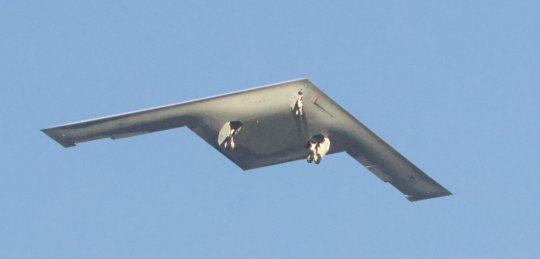
IMAGES: Fly the new USAF stealth bomber, the B-21 Raider
Fernando Valduga By Fernando Valduga 11/10/2023 - 15:14in Military
Photo: Matt Hartman
USAF's new B-21 “Raider” flying wing bomber made its first flight on Friday, the next step in the launch of a new fleet of nuclear-capable long-range stealth bombers built by Northrop Grumman.
The B-21 left the Northrop facility at U.S. Air Force Plant 42 in Palmdale, California, at sunrise on Friday at 6:51 a.m., offering the first improvised view of the new bomber that was developed under strict security.
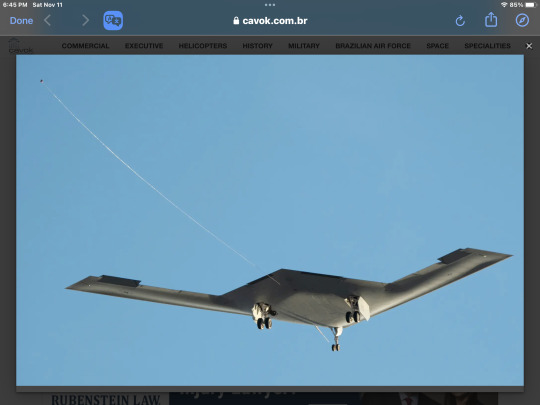
The aircraft went to Edwards Air Base, California, where it will continue with the flight test phase with USAF. The flight lasted about 90 minutes.
With the Cerberus callsign, the aircraft took off eastward with an F-16 companion plane after climbing about 500 feet. The landing gear was not collected, according to videos and photos that appeared on social networks.
TAP TITLE BAR TO VIEW VIDEO☝️
U.S. Air Force leaders did not disclose the first flight of the B-21, but about three dozen aviation enthusiasts and amateur photographers gathered around Plant 42 on Friday in the hope of seeing the bomber rise to the skies.

Photo: Mike Henry
The B-21, which carries the same "flying wing" format as its predecessor, the B-2, will be able to launch conventional and nuclear weapons around the world, using long-range and in-flight refueling capabilities.
The aircraft are projected to cost approximately $550 million each in 2010 dollars, or about $750 million in current inflation-adjusted dollars. However, the USAF kept other price information confidential, “which makes it difficult to validate the proposed cost,” the Congressional Research Service said in a 2021 report.
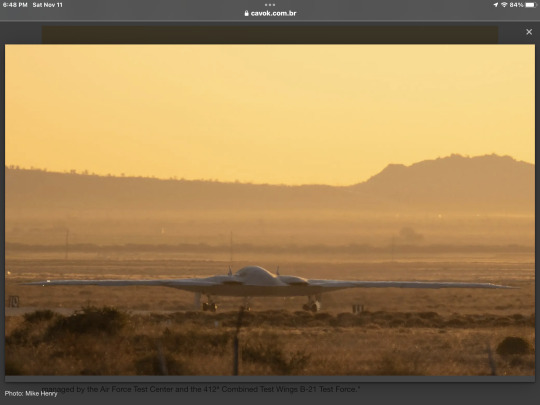
Photo: Mike Henry
The U.S. Air Force plans to buy at least 100 planes and start replacing the B-1 and B-2 bombers. The B-1 costs about US$ 60,000 per hour to operate and the B-2 costs about US$ 65,000 per hour, according to Pentagon data.
Ann Stefanek, USAF spokesperson, said: “The B-21 Raider is in flight tests. Flight tests are a critical step in the testing campaign managed by the Air Force Test Center and the 412ª Combined Test Wings B-21 Test Force."
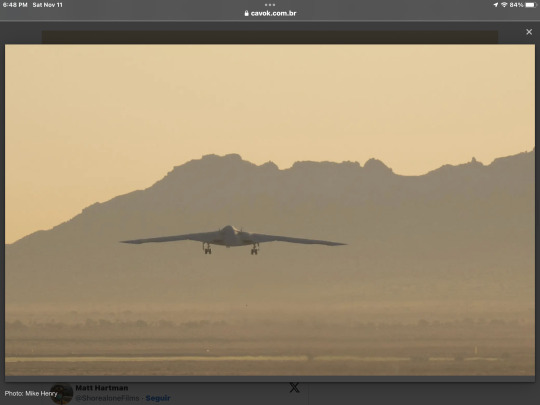
Photo: Mike Henry
Six test aircraft are being produced now. They are being built on the same line, using the tools, processes and technicians that will build the production aircraft.

Northrop defeated a team composed of Boeing and Lockheed Martin when it won the 2015 contract to manufacture the bomber. Engine manufacturer Pratt & Whitney, Collins Aerospace, GKN Aerospace, BAE Systems and Spirit Aerosystems are among more than 400 suppliers in 40 states.
The B-21 was publicly presented in December 2022, but the expectation around its first flight had been growing for years.
In 2019, an important Air Force general suggested that the bomber could fly as early as December 2021, but the Force subsequently postponed this date to mid-2022. In early 2022, the USAF postponed even more until 2023.
The B-21 program is in the engineering and manufacturing development phase and the first aircraft will be delivered to Ellsworth Air Force Base in North Dakota.
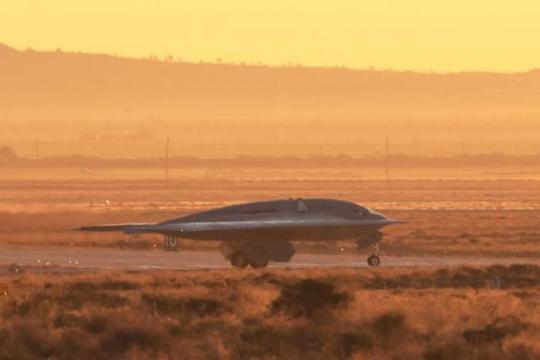
Northrop is calling the plane a sixth-generation aircraft due to its ability to connect to other aircraft and easily integrate future weapons into its systems architecture.

The B-21 also features surface material with low observation, more durable and stealthy, which should require less maintenance and reduce operating costs and downtime.
Tags: Military AviationNorthrop Grumman B-21 RaiderUSAF - United States Air Force / U.S. Air Force
Sharing
tweet
Fernando Valduga
Fernando Valduga
Aviation photographer and pilot since 1992, has participated in several events and air operations, such as Cruzex, AirVenture, Dayton Airshow and FIDAE. He has work published in specialized aviation magazines in Brazil and abroad. Uses Canon equipment during his photographic work in the world of aviation.
Related news
SAAB
Sweden will arm Gripen E fighters with anti-radar missiles
10/11/2023 - 18:00
DUBAI AIR SHOW
Russia will show the Il-76MD-90A and a line of civilian and combat helicopters at the Dubai Airshow
10/11/2023 - 17:00
MILITARY
Slovakia cancels military aid package to Ukraine
10/11/2023 - 14:00
MILITARY
Saab highlights Gripen E at a defense fair in Thailand
10/11/2023 - 09:00
The first Boeing T-7A Red Hawk, with the USAF test pilot Maj. Jonathan "Gremlin" Aronoff and Boeing test pilot Steve "Bull" Schmidt at the controls, arrive at Edwards Air Base on November 8, 2023 (Photo: U.S. Air Force / Todd Schannuth)
MILITARY
IMAGES: First T-7A Red Hawk arrives in Edwards to start the testing campaign with USAF
10/11/2023 - 08:10
MILITARY
Spain 'rejects' F-35 fighters and should focus on more Eurofighter Typhoons
09/11/2023 - 21:52
Client PortalClient PortalClient PortalClient PortalClient PortalClient PortalClient PortalClient PortalhomeMain PageEditorialsINFORMATIONeventsCooperateSpecialitiesadvertiseabout
Cavok Brazil - Digital Tchê Web Creation
Commercial
Executive
Helicopters
HISTORY
Military
Brazilian Air Force
Space
Specialities
Cavok Brazil - Digital Tchê Web Creation
26 notes
·
View notes
Text
man...... of course i knew aerospace (and its assorted, associated ills) was a huge industry here in my town, but i'm still super grossed out to see Northrop Grumman as our local pride fest's biggest sponsor
2 notes
·
View notes
Text
"They'll Erase You" - Super Elites, Invention Secrecy Act, Tesla, UFOs | Dr. Steven Greer | PBD
youtube
Remember the phrase 'unacknowledged special access programs'
#steven greer#pbd podcast#invention secrecy act#technology#nwo#history#cover up#ufos#deep state#fringe science#physics#aerospace#nikola tesla#shadow government#energy#space exploration#government cover up#propaganda#national security#medicine#CIA#military black sites#zero point energy#politics#david grusch#whistleblower#military industrial complex#military contractors#northrop grumman#lockheed martin
1 note
·
View note
Video
tumblr
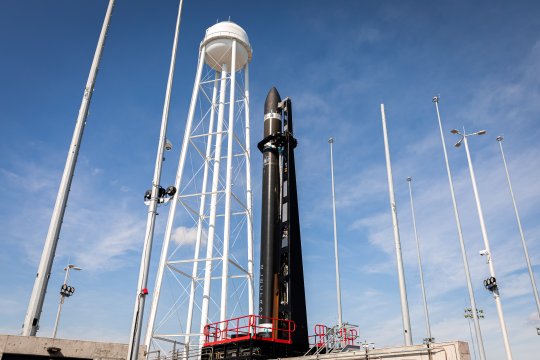


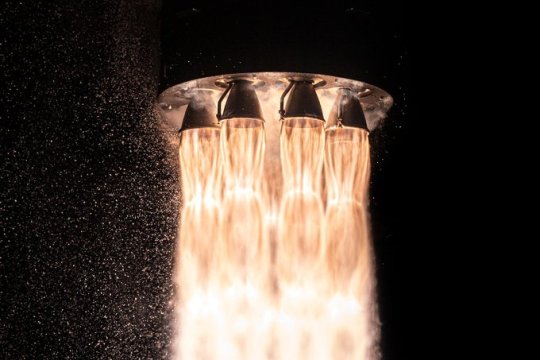

Rocket Lab Launches Electron Rocket from the US for the First Time
Rocket Lab, a prolific launch company that routinely blasts its towering Electron rockets out of New Zealand, conducted its first liftoff from US soil on Tuesday.
The mission, nicknamed “Virginia is for Launch Lovers,” took off from NASA’s Wallops Flight Facility on Virginia’s northern coast at 6 p.m. ET. The launch of the 60-foot (18.3-meter) rocket delivered three small satellites to orbit for the Earth-imaging company HawkEye 360, which uses a network of spacecraft to pinpoint radio frequencies on Earth in support of military and business projects.
Rocket Lab is among the most successful aerospace start-ups of the modern era. Unlike Elon Musk’s even more prolific rocket company, SpaceX, which builds larger rockets capable of hauling tens of thousands of pounds to orbit, Rocket Lab builds lightweight launch vehicles designed solely to lift small satellites — as compact as a loaf of bread or a refrigerator — to space.
Though the company has been headquartered in the United States since its inception, all of its prior launches have taken place at a pad near Ahuriri Point, located on the east coast of New Zealand’s North Island.
But Rocket Lab has sought for years to bring some of its launch operations stateside, in part so that it can provide services to the US government and military, which make up a lucrative slice of the global launch business customer base.
The NASA Wallops Flight Facility on Wallops Island in Virginia’s Accomack County is one of the oldest launch sites in the world. The first rocket flight took off from the site in 1945, before the creation of the space agency. More recently, the facility has been home to Northrop Grumman’s Antares rocket, which launches cargo resupply missions to the International Space Station.
By Jackie Wattles.
#Rocket Lab#Rocket Lab Launches Electron Rocket from the US for the First Time#Virginia is for Launch Lovers#Wallops Flight Facility#nasa#rocket#rocket launch#space#space mission
14 notes
·
View notes
Text
mechanical engineering job postings
aerospace engineer at Northrop Grumman. Work on defending America's beautiful soldiers with guided mortars. Protect democracy with our so so good rockets
aerospace engineer at NASA. Work on our so so good rockets to go to Mars (and also maybe to the middle east carrying a weapons payload)
aerospace engineer at SpaceX. work on our so so good rockets. as long as you can. bitch
aerospace engineer at some startup founded by SpaceX dropouts. it's all the culture problems of people who *wanted* to work at SpaceX without any of the mission successes!
cars
cars (Elon Musk flavored)
cars (Elon Musk dropout flavored)
mechanical engineer for a medical company! make tiny changes to little pieces of plastic that will take 5 years of design review to replace the existing little pieces. you might make people's lives better! eventually!
mechanical designer at some startup in Silicon Valley. commute 9 years to make this product that benefits primarily software engineers in San Jose
mechanical designer at some startup just outside Silicon Valley that's totally not a scam. we prommy
mechanical designer at a startup that seems like it's doing cool work but says "20% travel required" -> actually requires relocating to the middle of bumfuck nowhere
mechanical engineer at your ideal company (3,405 applications in last 3 days)
5 notes
·
View notes